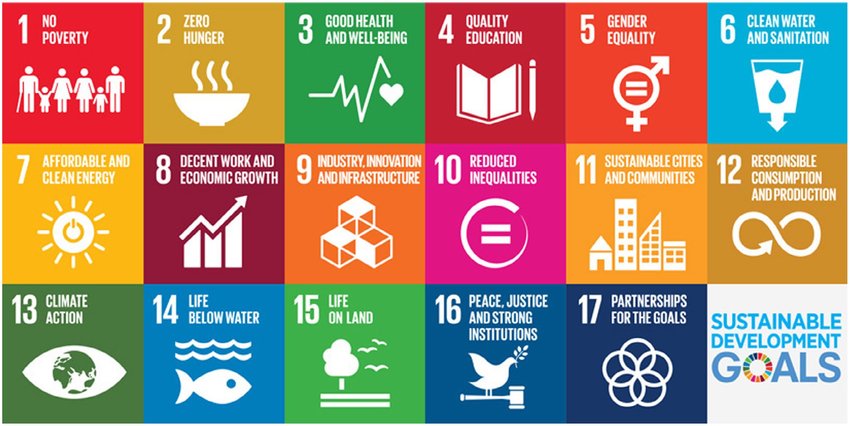In 2015, the United Nation General Assembly adopted the 17 sustainable development goals (SDGs, see figure) described as a “universal call to action to end poverty, protect the planet, and ensure that by 2030 all people enjoy peace and prosperity” [1]. These goals follow the previous set of Millennium Development Goals (MDGs) adopted in 1990 which were focused on reducing poverty, easing hunger and child mortality, and improving access to clean water and sanitation. As the consequences of climate change, like increased air pollution, sea level rise, drought, disappearance of ecosystems are affecting negatively more and more populations, the United Nation oriented the SDGs toward the limitation of climate change. Sustainable development aims at managing human activity to meet today’s population needs without compromising resources for future generations.
The Intergovernmental Panel on Climate Change (IPCC), the United Nation body responsible for assessing the science of climate change, reminds us that climate change and sustainable development are fundamentally connected. Indeed, limiting global warming can make it much easier to achieve the SDGs. Moreover, the connection is also made in a sense that, as mentioned previously, some of the SDGs are specifically dedicated to counteracting the effect of climate change, such as SDG 14 (life below water) and 15 (life on land) for protecting ecosystems, and SDG 13 (climate action) for taking urgent action to combat climate change. The result of this close link is that action in one area of the SDGs will affect outcomes in other areas, such as climate adaptation measures that benefit local ecosystems and health. The IPCC highlights the fact that adaptation measures have to be taken at all levels in order to favorize synergy between the different goals for sustainable development [2].
Biomedical research trying to improve patient’s everyday life can be used to support goal number 3: good health and well-being. As we are working in order to be useful to people, how can we make research activity more sustainable in practice from an environmental perspective? In 2020 an article titled “Ten simple rules to make your research more sustainable” was published in Plos Computational Biology by Anne-Laure Ligozat et al. In this article, the authors based their reflection on the SDGs and underline the fact that all human activity including research needs to be more sustainable by reducing the carbon footprint and environmental impact [3].
The ten rules described in the article are the following:
- Small actions are a good start to modify habits step by step.
- Be informed about carbon emitting activities and environmental issues. It can be done through reading summaries of Intergovernmental Panel on Climate Change (IPCC) reports or by being trained through formations and courses.
- Prefer train over plane to go to scientific meetings to limit CO2 emissions.
- Take advantage of remote participation to limit long distance travels.
- Work collectively and reproducibly through open science and sharing knowledge.
- Encourage bottom-up sustainable initiatives to engage the community.
- Evaluate the impact of the research practices.
- Ask sustainability research questions.
- Transfer ecofriendly gestures from home to the lab like plastic use limitation and recycling. A correspondence published in Nature in 2015 also mentioned the fact that labs should cut plastic waste too and that have greener lab practices could be a requirement in the grant application process [4].
- Raise awareness to go toward collective actions.
What stands out is that being informed and discuss this problematic are some of the most important points to initiate changes.
You can find more information about these rules in the article [3] and have a look at good practice initiative like S-Labs in the United Kingdom [5] and International Institute for Sustainable Laboratories in the USA [6].
[1] Sustainable Development Goals in action; available from: https://www.undp.org/sustainable-development-goals?utm_source=EN&utm_medium=GSR&utm_content=US_UNDP_PaidSearch_Brand_English&utm_campaign=CENTRAL&c_src=CENTRAL&c_src2=GSR&gclid=CjwKCAjwyryUBhBSEiwAGN5OCFL6AvKW_ek7MJUMPWuUrRmV5-DfWrhOAA3v4S-6FvClYTxBro7YKxoCYpAQAvD_BwE [cited 2022-05-30].
[2] What are the Connections between Sustainable Development and Limiting Global Warming to 1.5°C above Pre-Industrial Levels?; available from https://www.ipcc.ch/sr15/faq/faq-chapter-5/ [cited 2022-05-30]
[3] Ligozat A-L, Névéol A, Daly B, Frenoux E (2020). Ten simple rules to make your research more sustainable. PLoS Comput Biol 16(9): e1008148. https://doi.org/10.1371/journal.pcbi.1008148
[4] Urbina M, Watts A, Reardon E (2015). Labs should cut plastic waste too. Nature 528, 479. https://doi.org/10.1038/528479c
[5] Safe, Successful, Sustainable Lab; available from: http://www.effectivelab.org.uk/ [cited 2022-05-30].
[6] I2SL; available from: https://www.i2sl.org/ [cited 2022-05-30].

This article was written by Marie Moulin as part of an ongoing series of scientific communications written and curated by BioTrib’s Early Stage Researchers.
Marie is researching the Bioprinting of Bone and Cartilage at Uppsala University, Sweden.

